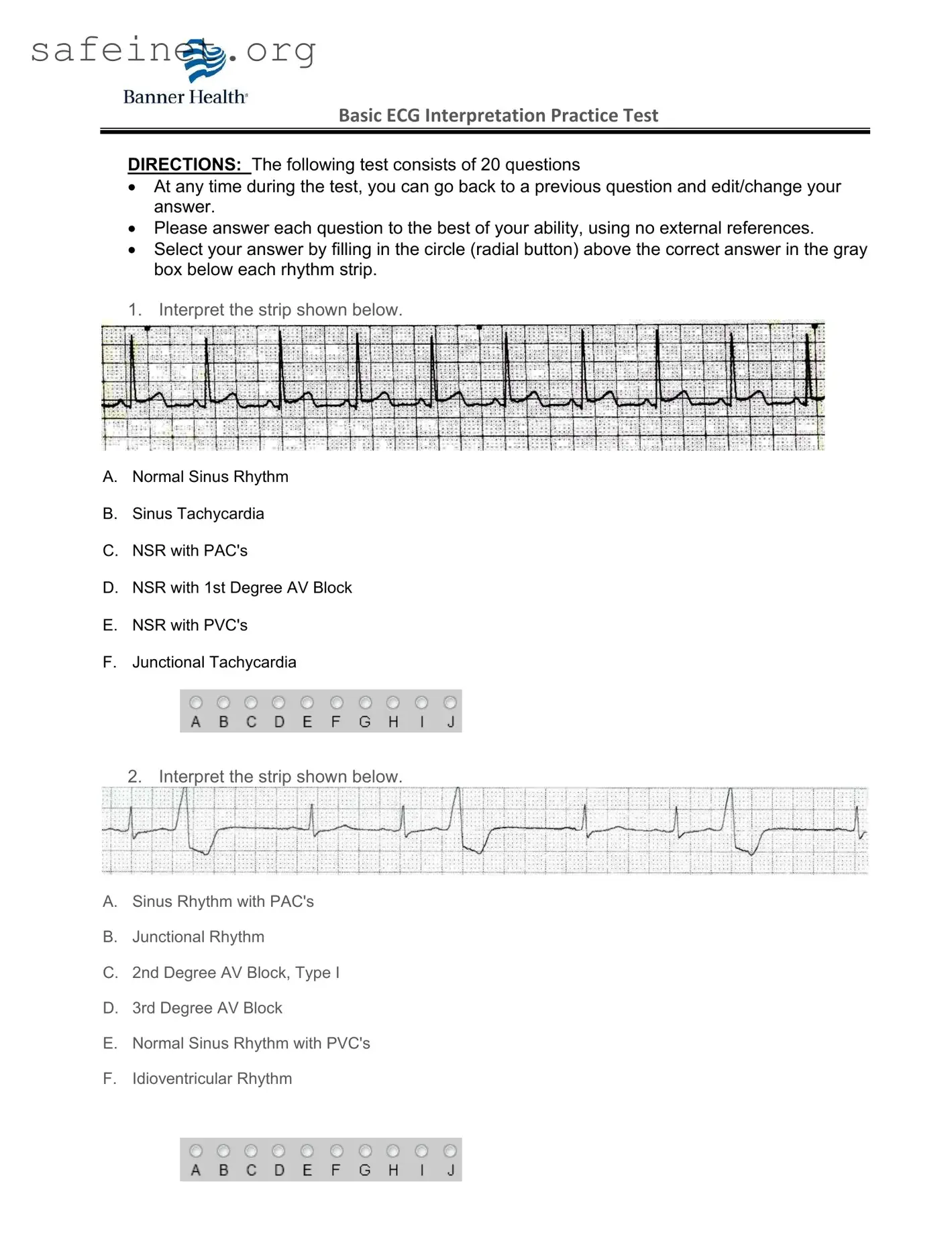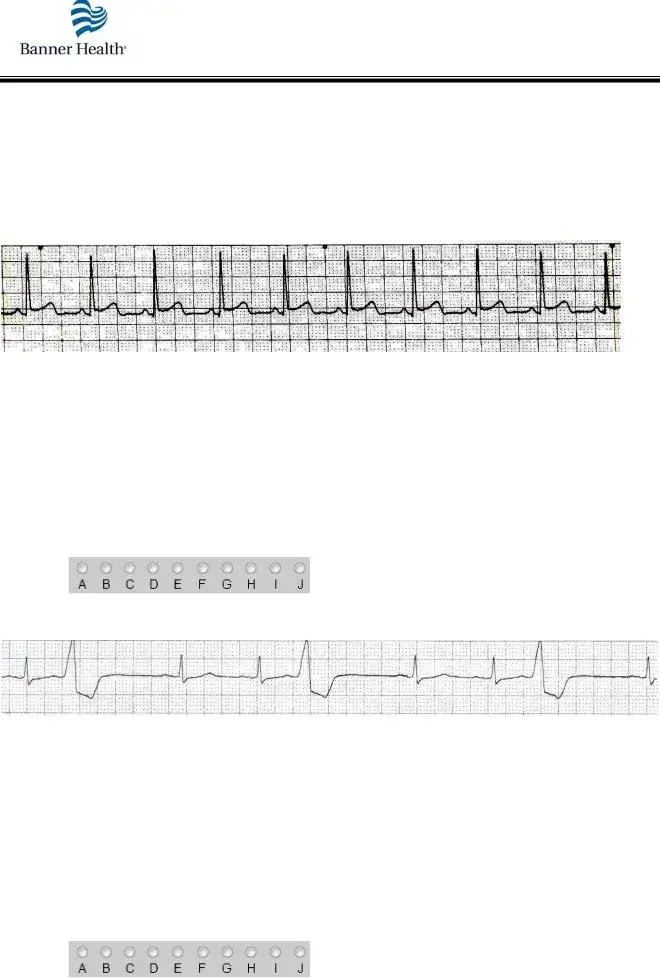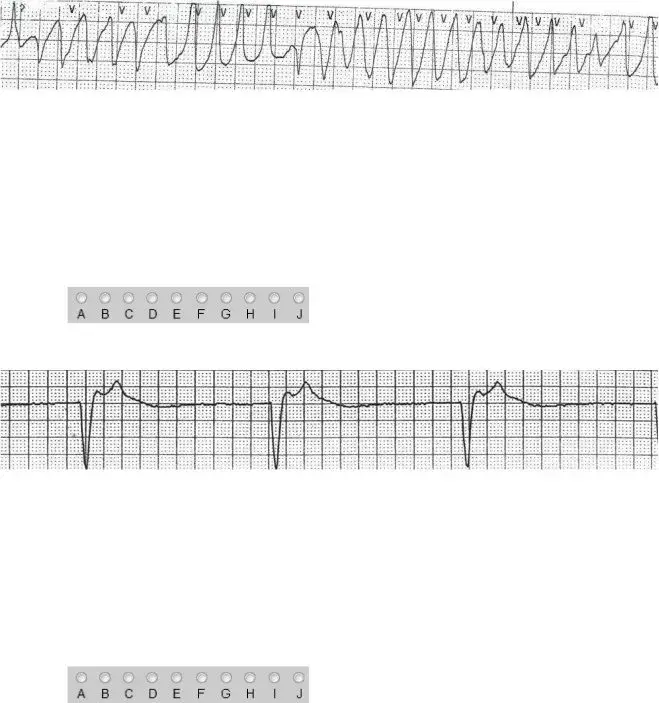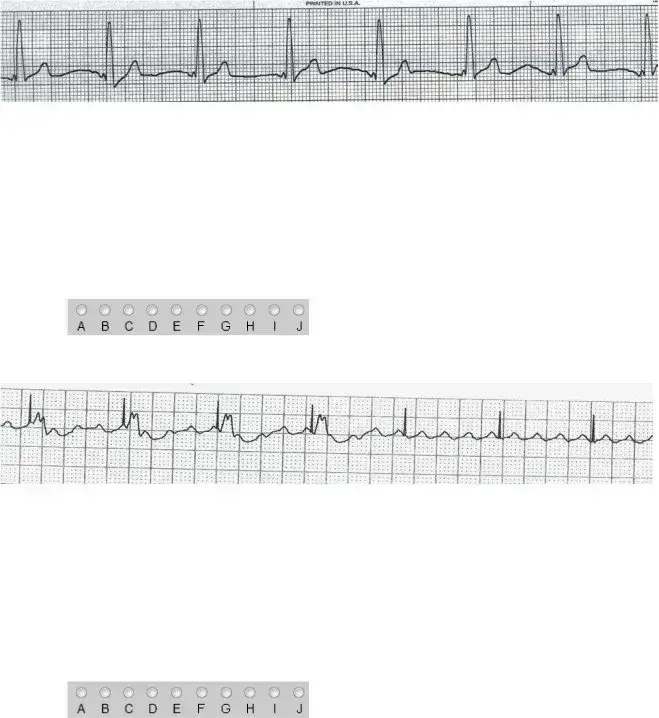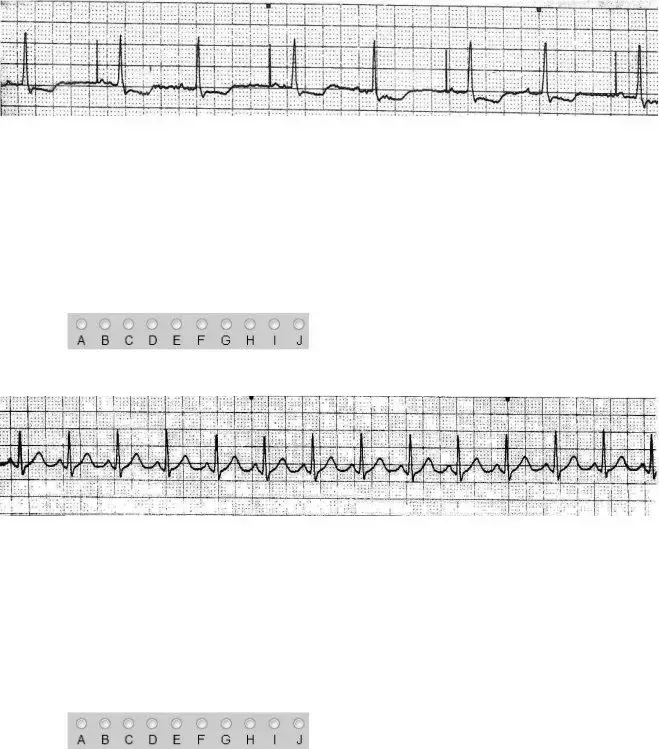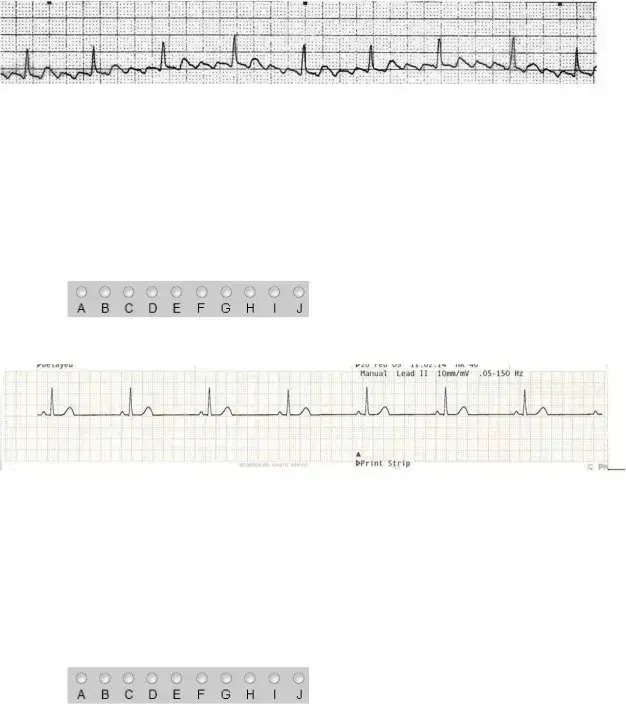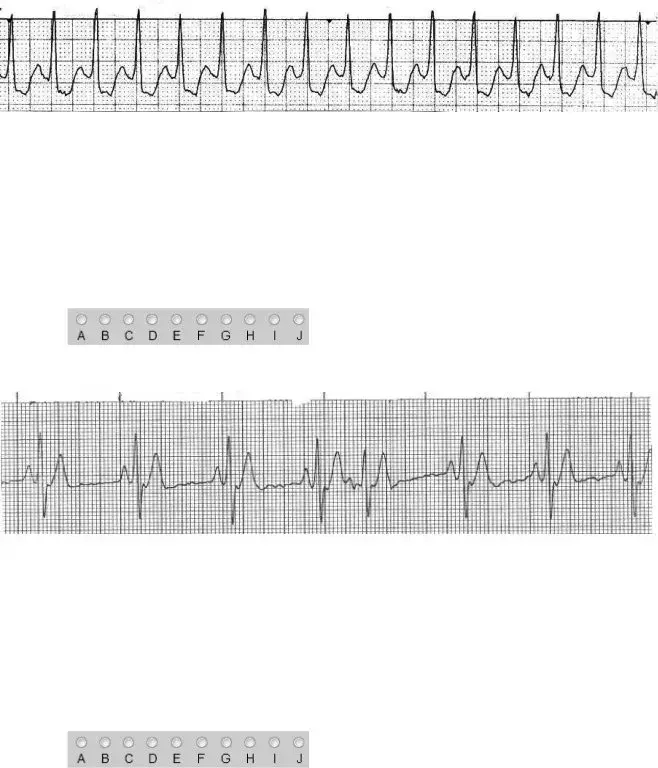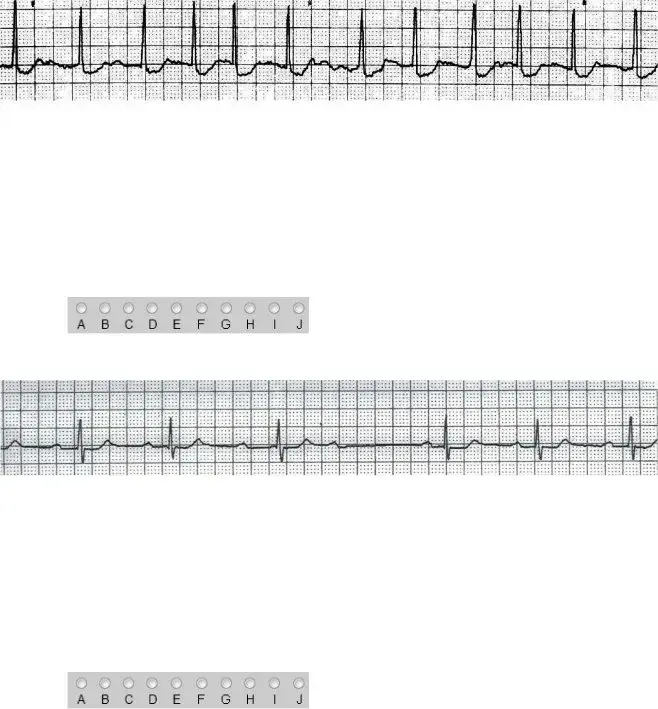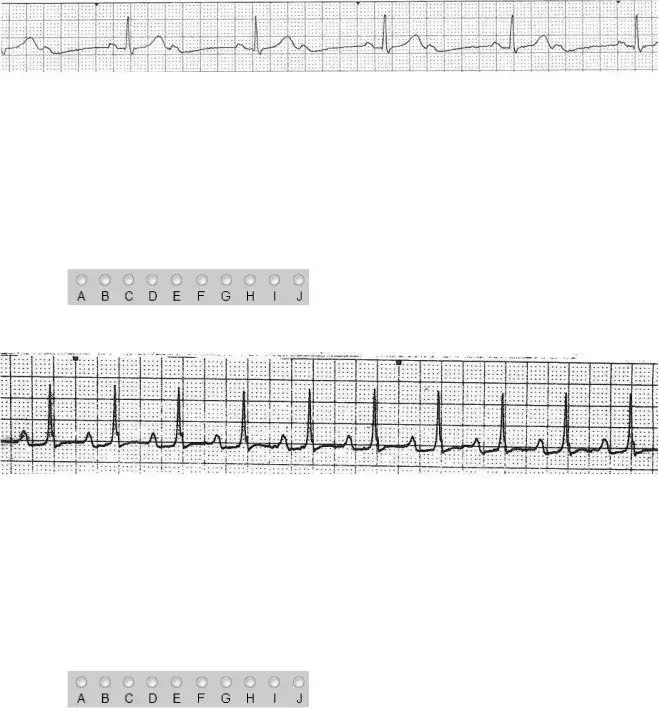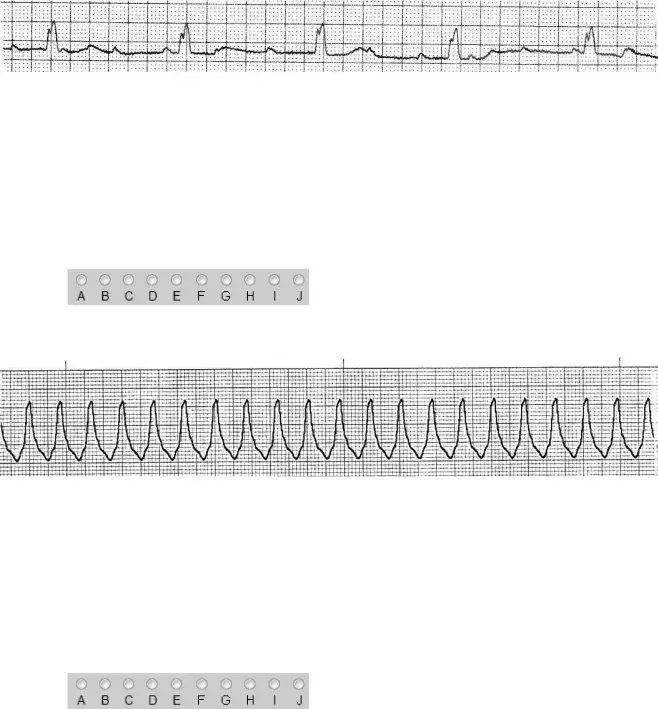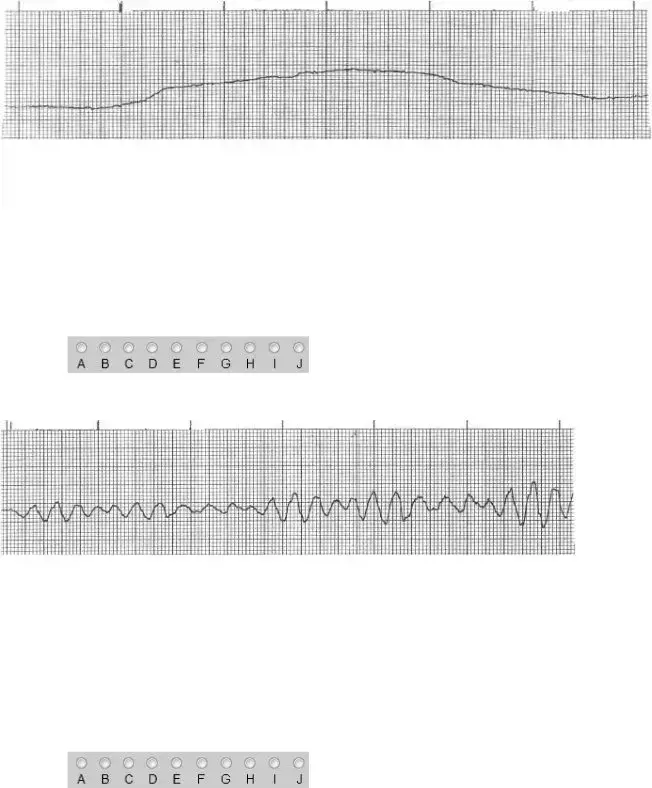Basic ECG Interpretation Practice Test
DIRECTIONS: The following test consists of 20 questions
•At any time during the test, you can go back to a previous question and edit/change your answer.
•Please answer each question to the best of your ability, using no external references.
•Select your answer by filling in the circle (radial button) above the correct answer in the gray box below each rhythm strip.
1. Interpret the strip shown below.
A.Normal Sinus Rhythm
B.Sinus Tachycardia
C.NSR with PAC's
D.NSR with 1st Degree AV Block
E.NSR with PVC's
F.Junctional Tachycardia
2.Interpret the strip shown below.
A.Sinus Rhythm with PAC's
B.Junctional Rhythm
C.2nd Degree AV Block, Type I
D.3rd Degree AV Block
E.Normal Sinus Rhythm with PVC's
F.Idioventricular Rhythm
3. Interpret the strip shown below.
A.Atrial Flutter
B.Idioventricular Rhythm
C.Ventricular Tachycardia
D.Torsades de Pointes
E.Ventricular Fibrillation
F.Asystole
4.Interpret the strip shown below.
A.Sinus Bradycardia
B.Atrial Fibrillation with Controlled Rate
C.Junctional Rhythm
D.2nd Degree AV Block, Type 2
E.3rd Degree AV Block
F.Idioventricular Rhythm
2 / 10
5. Interpret the strip shown below.
A.Normal Sinus Rhythm
B.Sinus Bradycardia
C.Accelerated Junctional Rhythm
D.NSR with 1st Degree AV Block
E.Idioventricular Rhythm
F.V Paced with Failure to Capture
6.Interpret the strip shown below.
A.Junctional Rhythm
B.3rd Degree AV Block
C.Idioventricular Rhythm
D.V-Paced with Non-sensing
E.V Paced with 100% Capture
F.V Paced with Failure to Capture
3 / 10
7. Interpret the strip shown below.
A.Junctional Rhythm with Ventricular Pacing
B.3rd Degree AV Block
C.Ventricular Tachycardia
D.Sinus Rhythm with Atrial Pacing
E.Sinus Rhythm with Ventricular Pacing
F.Sinus Rhythm with Failure to Capture
8.Interpret the strip shown below.
A.NSR
B.Sinus Tachycardia
C.Supraventricular Tachycardia (SVT)
D.Atrial Fibrillation with Rapid Ventricular Response
E.Atrial Flutter
F.Junctional Tachycardia
4 / 10
9. Interpret the strip shown below.
A.Sinus Tachycardia
B.Atrial Fibrillation
C.Atrial Flutter
D.Junctional Rhythm
E.Ventricular Tachycardia
F.Ventricular Fibrillation
10.Interpret the strip shown below.
A.Normal Sinus Rhythm
B.Sinus Bradycardia
C.Sinus Tachycardia
D.Junctional Rhythm
E.NSR with First Degree AV Block
F.2nd Degree AV Block, Type I
5 / 10
11. Interpret the strip shown below.
A.Sinus Tachycardia
B.Supraventricular Tachycardia (SVT)
C.Atrial Fibrillation with Rapid Ventricular Response
D.Idioventricular Rhythm
E.Ventricular Tachycardia
F.Asystole
12.Interpret the strip shown below.
A.Normal Sinus Rhythm
B.Sinus Rhythm with PAC
C.Sinus Rhythm with PJC
D.NSR with First Degree AV Block
E.2nd degree AV block type II
F.Sinus Rhythm with PVC
6 / 10
13. Interpret the strip shown below.
A.Sinus Tachycardia
B.Sinus Rhythm with PAC's
C.Supraventricular Tachycardia (SVT)
D.Atrial Fibrillation
E.Atrial Flutter
F.Junctional Rhythm
14.Interpret the strip shown below.
A.Sinus Rhythm with PAC's
B.Junctional Rhythm
C.NSR with 1st Degree AV Block
D.2nd Degree AV Block, Type I
E.2nd Degree AV Block, Type II
F.3rd Degree AV Block
7 / 10
15.Interpret the strip shown below.
A.Sinus Rhythm with PAC's
B.Junctional Rhythm
C.NSR with 1st Degree AVB
D.2nd Degree AV Block, Type I
E.2nd Degree AV Block, Type II
F.3rd Degree AV Block
16.Interpret the strip shown below.
A.Normal Sinus Rhythm
B.Junctional Escape Rhythm
C.NSR with 1st Degree AV Block
D.2nd Degree AV Block, Type I
E.2nd Degree AV Block, Type II
F.3rd Degree AV Block
8 / 10
17.Interpret the strip shown below.
A.Sinus Bradycardia
B.Junctional Rhythm
C.NSR with 1st Degree AV Block
D.2nd Degree AV Block, Type I
E.2nd Degree AV Block, Type II
F.3rd Degree AV Block
18.Interpret the strip shown below.
A.Supraventricular Tachycardia (SVT)
B.Atrial Flutter
C.Ventricular Tachycardia
D.Torsades de Pointes
E.Ventricular Fibrillation
F.Asystole
19. Interpret the strip shown below.
9 / 10
A.Atrial Fibrillation with Controlled Rate
B.Idioventricular Rhythm
C.Ventricular Tachycardia
D.Ventricular Fibrillation
E.Asystole
F.V Paced with 100% Capture
20.Interpret the rhythm strip shown below.
A.Atrial Fibrillation
B.Idioventricular Rhythm
C.Ventricular Tachycardia
D.Atrial Flutter
E.Ventricular Fibrillation
F.Asystole
10 / 10
